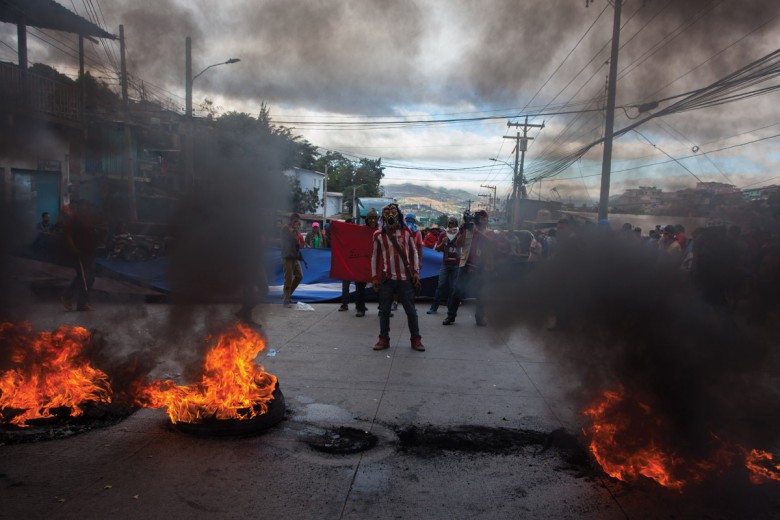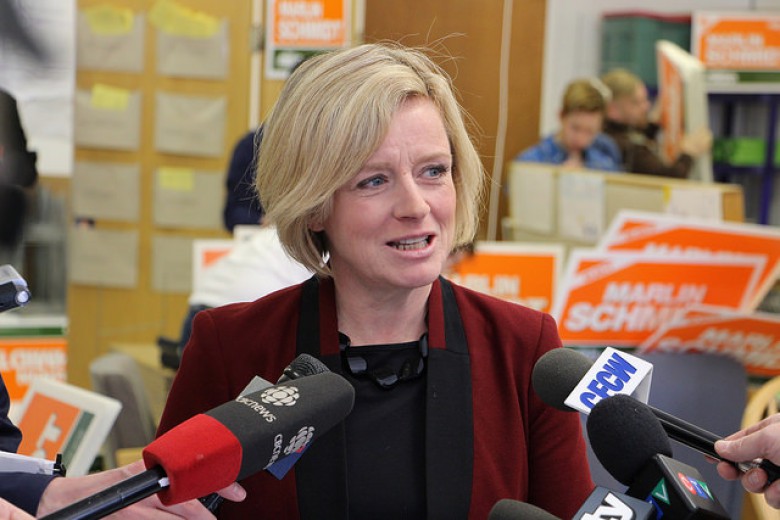“You’re only allowed to participate in the system if you’re acceptable and if you’ve gone through the right channels. And the power to determine who is acceptable and who has gone through the right channels still rests with the party,” says disqualified B.C. NDP leadership candidate Anjali Appadurai.
A climate justice organizer, Appadurai’s platform included plans to address the province-wide health care crisis, promote unionized green jobs, provide free universal transit, and implement the Declaration of the Rights of Indigenous Peoples Act, all under the umbrella of what her campaign called the Healthy Climate Plan.
While Appadurai was relatively new to electoral politics, she has years of experience in climate justice advocacy, and her platform spoke to voters. Despite entering the race weeks after her opponent, David Eby, Appadurai’s team signed as many as 14,000 new members to the B.C. NDP, 10,000 more than Eby’s, according to some reports.
“Those responsible for overseeing the leadership contest should have done more to ensure it was a fair process.”
But during a closed-doors, hours-long meeting, the provincial party executive voted to uphold chief electoral officer Elizabeth Cull’s recommendation to disqualify Appadurai. The report claims Appadurai engaged in “improper conduct” by coordinating with third parties such as the environmental non-profit organization Dogwood, and determined the new memberships her team signed to be “fraudulent.” The race, and the office of B.C. premier, went to NDP establishment favourite Eby.
Notably, the rules Appadurai’s team is accused of violating were not in place at the time of the supposed infraction – they were changed and applied retroactively, ending Appadurai’s successful, grassroots campaign.
Why would the NDP shut out a popular candidate who was engaging thousands of activists and new and former NDP members two years before the next provincial election?
According to former candidates and activists from B.C., Alberta, and Saskatchewan, the NDP has a democracy problem, and Appadurai isn’t the first climate justice activist or racialized woman to be shut out of the party.
“How dare she”
In a 2016 by-election, Navjot Kaur ran for city council in Edmonton’s Ward 12. She didn’t win, but what she describes as her “slapdash but highly effective, highly efficient campaign” did get her noticed by the Alberta NDP.
She wasn’t affiliated with the AB NDP at that point, but they took up support of her campaign, and she later organized within the party, forming the provincial Race Equity Caucus with fellow organizer Hijal De Sarkar.
But, internally, the creation of the caucus was perceived as antagonistic, and by association, so was Kaur, leading her to take a step back from organizing with the NDP. Kaur had hoped to bring her expertise as an organizer and educator to the party, along with her strong community ties. But what she considers to be assets, the party considers risk factors.
“The only way a racialized person can be acknowledged is to become institutionalized,” Kaur explains. She says the party’s message is: “Once you get into the NDP, you need to fall into line with us.”
Kaur explains the other side of this coin is Appadurai’s case. Appadurai ran as an outsider, never having gone through the institutional channels that the establishment expects of candidates.
“With the Appadurai campaign, I knew right away [her elimination] was going to be due to some kind of technicality,” recalls Kaur. “Because she hasn’t gone through the ringer. She hasn’t risen up through the ranks. She hasn’t earned that. How dare she? How dare she do that?”
“You’re only allowed to participate in the system if you’re acceptable, and if you’ve gone through the right channels. And the power to determine who is acceptable, and who has gone through the right channels, still rests with the party.”
Appadurai is open about how her choice to run as a climate justice activist, without the approval of the B.C. NDP, impacted her campaign. “Time was so incredibly short, when the race kicked off, and I felt a deep sense of accountability to the broader movement, whose views and politics I was representing in this race,” she tells Briarpatch.
“I understand that folks were offended,” she explains. “It seems that my bid was received as a disrespectful act toward the existing team of the caucus. I was not intending any disrespect, especially on a personal level, to any member of caucus. I was doing politics, and I was challenging power. But it was perceived as an open act of defiance and disrespect. And so leading up to the disqualification, the overwhelming sense was that there was a lot of animosity at play.”
This runs parallel to the experience of Kaitlyn Harvey, a Métis environmental lawyer and longtime climate justice activist who ran for the provincial seat of Saskatoon Willowgrove in 2020 and for provincial NDP leadership in 2022.
“I know some folks in the party felt I was too new, too young, and too progressive to hold the position of leader, and I was seen as a threat for coming up ‘out of nowhere’ and asking for the opportunity to lead the party in a new direction when I haven’t earned my stripes yet,” explains Harvey.
“It’s a sign of illness in the democratic system [...] when partisanship rises above a true discussion of, or true recognition of, the crisis that we are facing.”
Harvey held representative seats on two provincial executive associations, the Saskatoon Metro Assembly, Provincial Council, and the Indigenous New Democrats of Saskatchewan, and felt she could grow the party and expand its reach further than her opponent could.
“I would not have stepped forward if I didn’t think I had enough experience and knowledge of the party’s internal and external issues to do a good job,” Harvey shares.
Similar to Appadurai, Harvey’s bid for leadership and her platform, the Sustainable Saskatchewan Strategy, was well received by voters. Despite entering the race weeks after eventual winner and current provincial party leader Carla Beck, her campaign earned her 32 per cent of votes. In Harvey’s case, there was no cloaked policy change, but she describes “discriminatory practices” and deliberate obstruction of her campaign.
“Those responsible for overseeing the leadership contest should have done more to ensure it was a fair process. That interference and silencing by certain people within the party pushes away the very people the party needs support from, and ought to be supporting, namely, BIPOC volunteers and candidates, youth, and supporters of significant policy reform and positive progress in the areas of healthcare, education, housing, justice, environment, and economic development.”
Harvey says the party assigned NDP volunteers to organize the leadership race that were explicitly and publicly in support of Beck, her competitor. “Some of them were openly, actively supporting Carla for a very long time,” she shares. “Then I step forward and suddenly, the party is scrambling to find “qualified” and independent people to organize the race. The only people they can think of have been working to get Carla elected all along. They were supposed to be neutral parties organizing a fair, democratic election, but that’s not what my experience was. And I know I’m not alone in this regard.”
“I would not have stepped forward if I didn’t think I had enough experience and knowledge of the party’s internal and external issues to do a good job."
Harvey first became involved with the provincial NDP during the 2020 election, when she was asked to be a paper candidate by the party’s former leader, Ryan Meili. He asked her to run in Saskatoon Willowgrove, which Harvey explains is the right-wing Saskatchewan Party (Sask Party)’s second most secure seat in the province. That is, she was not expected to win but was invited to run for practice.
Harvey lost to incumbent Ken Cheveldayoff, but despite having only a month-long campaign, she still managed to get 1,400 more votes than the previous NDP candidate running in that constituency. She describes the campaign experience positively, saying that she expected resistance as an NDP candidate in a staunchly Sask Party riding, but instead was pleasantly surprised by how many Willowgrove residents engaged with her platform.
“My experience running in Willowgrove was so positive,” she remembers. “Every day I went out and talked to people, I was filled with more and more hope for the NDP. People were so receptive on the doorstep, and I could almost see they were relieved to talk about it. It was just really great conversation. And every day, I felt more and more inspired, that there’s hope for climate action in Saskatchewan, and reconciliation, and all of these things that we so desperately need in this province.”
The party’s message is: “Once you get into the NDP, you need to fall into line with us.”
After the 2020 election, Harvey says she really “dove into the NDP,” joining her constituency executives at the Saskatoon Metro Assembly and eventually also at the provincial council. She is now the vice president Métis of the Indigenous New Democrats of Saskatchewan.
And when Carla Beck, now party leader, was running unopposed in 2022, Harvey decided to jump in.
“I saw this as an opportunity to put forward what I thought we needed to do,” she says. “I looked at it as a survey. You know, here’s what we’re talking about. Here’s what we want for the province. So if you want it too, you can vote for it. And nobody expected us to get as much of the vote as we did.”
Bringing climate to the fore
Like Harvey, the B.C. leadership race was Appadurai’s second election, as she had run in Vancouver-Granville in the 2021 federal election, losing by just 431 votes to Liberal MP Taleeb Noormohamed.
Despite being “green” when it comes to party politics, Appadurai and her campaign appealed to voters. Along with signing thousands of new members to the B.C. NDP during the race, a petition to appeal the provincial executive’s decision and #LetHerRun garnered over 10,000 signatures in less than 24 hours after the party’s decision to disqualify Appadurai was made public.
Over in Saskatchewan, Harvey is in a very different political landscape. In B.C., former NDP leader John Horgan was serving his second term as premier when he stepped down and triggered the leadership race, while the SK NDP haven’t held power in the province since 2007 and are up against the 26-year-old Liberal-Progressive Conservative amalgamated Sask Party.
“[Voters are] actually really worried about climate change. And they want politicians to just stop bullshitting them and do what needs to be done.”
Nevertheless, Harvey’s campaign once again demonstrated voter interest in a climate justice-oriented platform. “We were getting a lot of engagement,” says Harvey of the 12-week campaign. “I wasn’t surprised with the 32 per cent [of the vote]. Probably other people within the party were surprised that I was being received so positively. Maybe that’s why they resorted to some of the unfair tactics they did.”
Harvey and Appadurai’s success demonstrates how important climate justice is to voters. But will they be voting for the NDP?
“We’ve got this voter apathy, and people making policy because they think this is what the voters care about,” explains Harvey. “[Voters are] actually really worried about climate change. And they want politicians to just stop bullshitting them and do what needs to be done.”
“I know some folks in the party felt I was too new, too young, and too progressive to hold the position of leader, and I was seen as a threat for coming up ‘out of nowhere’ and asking for the opportunity to lead the party in a new direction when I haven’t earned my stripes yet.”
So where does this leave climate justice activists? Not in a good place with the NDP, according to Harvey, until the party addresses its democracy problem.
“People want change from outside the party and within, but I don’t think that will come until the party addresses its internal biases. Whether intentional or not, they are there, and the party and province is suffering as a result. Candidates of colour, climate activists, and people who are seen as not electable, or less electable, they don’t get the same level of support and respect as other, more ‘electable’ candidates do. But we are more than just butts in a seat or names on a ballot. This is supposed to be our party just as much as it is anyone else’s.”
In B.C., climate action appears beyond urgent, as the last two years alone have seen wildfires, flooding, landslides, and the destruction of the community of Lytton in one day in June 2021, killing two residents. The B.C. Coroners Service reported at least 526 deaths due to extreme heat between June 25 and July 1, 2021, alone.
“It’s disappointing,” says Appadurai, “because for those of us who are advocating [for] something that is globally accepted to be one of the greatest threats to our future, the advocacy has to not only work to win over the public, but it also has to work to win over a myopic political class. The Eby camp’s unwillingness to tackle climate [issues] until I became a genuine threat in the race was a very clear prioritization of the politics above the issues.”
“You’re only allowed to participate in the system if you’re acceptable, and if you’ve gone through the right channels. And the power to determine who is acceptable, and who has gone through the right channels, still rests with the party.”
Party politics with the SK NDP appear to be in the same vein. For example, a constitutional amendment was put forward at last October’s annual convention by the Regina Lakeview constituency (Carla Beck’s riding), which proposed limiting the vote in future leadership races to only those attending the convention.
Had the resolution passed, it would have meant that instead of any NDP member in Saskatchewan voting in a party leadership race, only members at the leadership convention would be able to vote. According to Harvey, this change could limit voting in leadership races only to those who are involved with their constituency associations and are permitted by the executive to be a delegate, which she calls “a step in the wrong direction” if the volunteer-based party is serious about increasing public participation and support.
“There is speculation we will see more attempts like this to limit participation by those who don’t ‘toe the party line,’” Harvey shares.
Who is the NDP for?
In Saskatchewan, low volunteer numbers are an issue, one Harvey thinks won’t be solved without a platform that inspires and excites people and gives them a reason to get involved. “We don’t have enough people stepping up, filling the roles, the committees, being present to do the work,” Harvey explains. “Then when it comes time for elections and campaigns, and you need people to do the work, they’re calling on the same group of people. And so they know each other, they know the game.”
Back in B.C., the NDP doesn’t seem to be worried about engaging new members, given the investigation into Appadurai’s alleged “fraudulent memberships.” Appadurai’s team was not able to confirm how many newly registered party members were contacted by the NDP as part of Cull’s investigation, though a recording of one of the calls confirms that new members were asked why they decided to join the NDP, how long they had been NDP supporters, to confirm that they weren’t supporters of any other provincial or federal party, and about previous party affiliations and donations.
In addition to disqualifying Appadurai by creating new campaign rules, Appadurai’s campaign manager Harrison Johnston says the B.C. NDP also failed to share the B.C. NDP code of conduct, presumably detailing campaign rules, with Appadurai and her campaign team at any point during her race, despite multiple requests.
“There is speculation we will see more attempts like this to limit participation by those who don’t ‘toe the party line.”
While the timing of the rule changes and details from the investigation point to a large-scale attempt by the party to find fault with Appadurai’s campaign, comments made by former B.C. premier John Horgan also speak to the political culture Appadurai says she was wary of before getting involved in electoral politics.
Outside the B.C. legislature the day after the vote to disqualify Appadurai, reporters describe Horgan as “angry.” Speaking to the Vancouver Sun, the former premier described Appadurai and her team’s campaign as “thuggery” by “a bunch of people who cheated and want to get away with it.”
That the B.C. NDP would smear a candidate who had engaged over three times the number of potential members their opponent did, and alienate (at best) or intimidate (at worst) those new members with phone inquiries raises – or, truthfully, shouts – the questions: who is the NDP for and what are its values?
"The Eby camp’s unwillingness to tackle climate [issues] until I became a genuine threat in the race was a very clear prioritization of the politics above the issues.”
“It’s a sign of illness in the democratic system,” says Appadurai, “when partisanship rises above a true discussion of, or true recognition of, the crisis that we are facing, that we’re all facing commonly. And I think that that’s what’s happening here in B.C.”
The hostility of the party establishment isn’t the only barrier facing candidates. In Appadurai’s case, the antipathy from the NDP was intertwined with practical barriers, like the exorbitant application fee associated with running for party leader.
On the day of Appadurai’s disqualification vote, she hadn’t yet been approved as a candidate but was asked to pay the balance of the fee by 5 p.m., an hour before the meeting to vote on her disqualification began. If she didn’t pay, she risked disqualification for missing the fee, regardless of the vote. Her balance? A whopping $25,000, out of a total fee of $40,000.
Though granted a few hours’ extension in response to a social media post by a journalist that same day, Appadurai did not end up paying the remainder of the fee, since she was disqualified.
In Saskatchewan, the fee to run for party leader is $4,000. When Harvey ran, she was fresh out of grad school and bogged down by student debt, and her mother had to take out a personal loan to cover the cost.
Harvey explains that she didn’t have funding to hire her own staff or pay for her own advertising, either. She had no choice but to accept the limited support offered by the SK NDP, which included taking on a staff person who was open about their support of her opponent in the race, and making the most of a single NDP-paid mail-out (on which, she describes with a laugh, she squeezed as much information as possible, covering both sides of a page with text and a QR code taking readers back to her campaign website).
Is there hope for justice in electoral politics?
Huge fees, hidden documents, and changing rules are just a few examples of the barriers built into our electoral system, and these are the kinds of issues that should be addressed through open, accessible, and public education, according to Kaur.
Kaur adds that political education is critical, especially for Indigenous, Black, and racialized people, newcomers, and those without inherited access and the cultural capital necessary to navigate party politics.
“I had to make a choice,” notes Kaur of her experience with the NDP. “Either we blend in, or we advocate for education, and [we] acknowledge, essentially, the barrier there is for us to be able to understand the mechanisms and be able to advocate for ourselves, join political institutions, and be able to show up appropriately, plan appropriately. But this is gatekept information.”
Even Appadurai, who has studied and worked in the field of political advocacy and social movements for years, learned through this campaign about the scope of riding associations.
"This is supposed to be our party just as much as it is anyone else’s.”
“Suddenly, I’m learning and realizing that we have hundreds of community organizations, these riding associations that are federal and provincial, across the province, serving specific neighbourhoods, serving specific communities, with their own governance and existing infrastructure,” she describes. “I’m realizing that these are our democratic institutions and that they have been hollowed out by power being far too centralized within a political party.”
Kaur is one of the founders of the Courage Coalition. The coalition aims to address this disconnect by creating a middle ground between the NDP establishment and grassroots organizing in Canada, to foster allyship and support folks looking to get involved with the NDP anywhere in the country.
As for Appadurai, she is returning to non-profit climate advocacy with a new project, the Padma Centre for Climate Justice, a resource hub that she hopes will “tell a better story of climate justice – one that connects global economic issues and colonialism to the climate crisis.”
Harvey remains engaged with the NDP and hopeful for the future. However, like Appadurai and Kaur, she is also building on non-partisan, information-oriented advocacy by working on converting her former campaign domain to a resource that shares information on climate justice and other justice movements in Saskatchewan.
“I could have been a paper candidate twice,” Harvey declares. “I decided I’m gonna use this opportunity to talk to people and see if they have questions, concerns, anything I can answer, anything I can help with. This would be just a really great opportunity, and I took it. When I ran for leadership my plan B was winning. With no money and still in COVID, it was really difficult to meet people, and we still took 32 per cent of the votes. So again, I’m still filled with hope, and I’m still here within the party.”






